William Bradford: Sailing Ships & Arctic Seas
Opened: June 1, 2003
On May 23rd, the art of marine and Arctic painter William Bradford (1823-1892) went on view as the showcase exhibition of the New Bedford Whaling Museum’s centennial year. On view through Oct. 26th, William Bradford: Sailing Ships & Arctic Seas was comprised of 68 oil paintings—many shown in public for the first time—as well as drawings, prints, sketchbooks and photographs drawn from museums, galleries and private collections throughout the country.
An accompanying 178-page catalogue illustrates all exhibited items and provides new information on Bradford’s career by authorities on his life and work.
Bradford began to paint in New Bedford in 1852, having failed as the proprietor of a clothing store, because, as he said, “I spent too much time painting to succeed.” Setting up a studio overlooking the harbor, he found his first subjects among the whaleships of the port, now approaching their highest number and bringing the city its greatest prosperity. Painting their portraits for owners and captains, he drew on his knowledge of hull form and rig derived from his family’s involvement as merchants and shipbuilders in the whaling trade. Before long, he traveled to Boston to paint more lucrative portraits of the larger clipper ships of that port in the same precise and accurate style.
As “the broadside of a vessel became absolutely loathsome to me,” Bradford set out to improve his art. Entirely self taught, in 1854 he acquired as a teacher and sometimes collaborator a recent immigrant trained in the Dutch school of marine painting, Albert Van Beest (1820-1860). Under his influence, Bradford began to paint more ambitious scenes of maritime activity in the harbors of New Bedford and Boston, as well as of ships in distress, yachting regattas and coastal views in Maine and the Bay of Fundy.
In 1861, with a mature style of his own, Bradford began the series of northern voyages that would bring him fame as the painter of the Polar Regions. Six cruises in chartered schooners brought him to the coast of Labrador, where ice-clogged harbors, crude summer settlements of Newfoundland fishermen and the distinctive light of a cold climate gave him subjects that advanced his reputation. Among them, the six-by-ten foot Sealers Crushed by Icebergs (1866) attracted large audiences during its multi-city tour as a single-painting exhibition and sold for a record-setting price.
Even after the Labrador voyages, the Arctic lured Bradford to an extraordinary expedition in pursuit of art. Chartering the Bark Panther, a sealing vessel with auxiliary steam power, he set off in the summer of 1869, bound up the Greenland coast and as far above the Arctic Circle and as ice permitted. Reaching Melville Bay before being forced to turn back by impenetrable pack ice, he returned with scores of oil sketches, sketchbook drawings and over 300 photographs taken by two professionals in his party. From this material, he would work up in studios in New York, London and San Francisco the paintings for which he became famous, here and abroad.
In England for the portion of each year between 1871 and 1874, he enjoyed the most rewarding period of his career, due in part to the commission of a painting by Queen Victoria. The Monarch also headed the subscription list for his costly, oversized book, The Arctic Regions (1873), which contained his narrative of the Panther voyage, illustrated with 141 photographs, themselves among the earliest taken of the frozen world.
After London, Bradford established a seasonal studio in San Francisco, where he painted from 1875 and 1881 both Arctic views and those of Yosemite Valley, the Sierra Nevada and other western mountain sites. In the 1880s, he and other artists of his generation suffered from a shift in taste, away from realistic depiction of the natural wonders found on the nation’s frontiers to more recent innovations in technique and subject matter by painters who studied or observed the art scene in Europe.
By the time of his death in 1892, Bradford’s reputation, along with those of his fellow artist-explorers, was fast declining. More than half a century would pass before a revival of interest in their paintings began to take place, expressed in exhibitions, publications and prices realized for their works. With Bradford, this exhibition in New Bedford offered a welcome opportunity for the full-scale reassessment of the work of a master of marine painting and a unique portrayer of the Arctic world.


